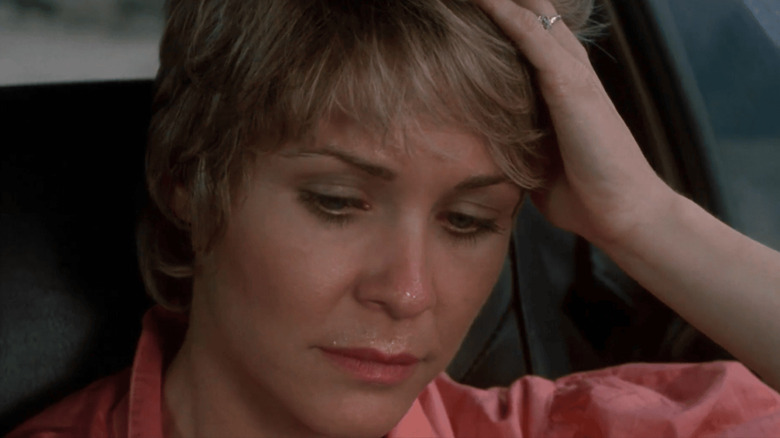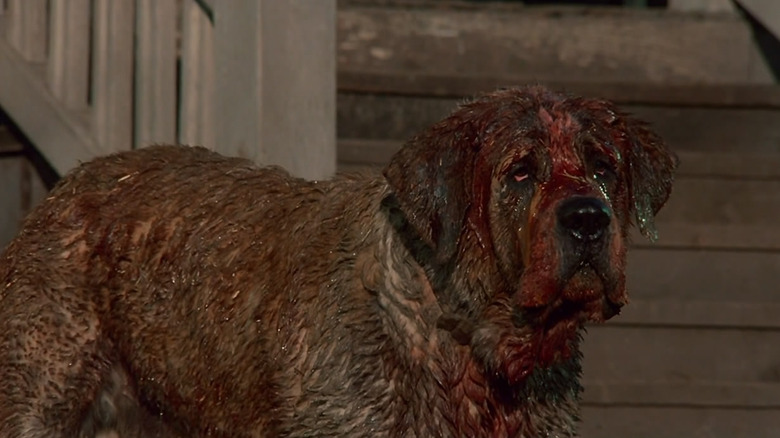Why Cujo's Lead Star Demanded A Different Ending For The Stephen King Adaptation
Stephen King's 1981 novel "Cujo" is about a Saint Bernard dog that contract rabies from a bat and goes on a killing spree. The dog, Cujo, belonged to an abusive mechanic, so it was already seemingly predisposed to violence. It mauls several people throughout the course of the story. The novel climaxes with a local mom named Donna Trenton and her young son Tad becoming trapped in a Ford Pinto on a hot day as Cujo stalks them from outside. There comes a moment when Donna has to choose to stay in the car and risk dying of heat stroke ... or exiting the car and facing the killer dog.
In the book, Donna successfully fights off Cujo with a baseball bat, beating the dog and stabbing it to death with a shard when the bat breaks. Tad, sadly, does not survive the ordeal, dying of heatstroke in the Pinto.
"Cujo" was a bestseller and was popular enough to be adapted into a feature film in 1983. The film, directed by Lewis Teague and written by Don Carlos Dunaway & Barbara Turner, followed the climax of the novel closely, with Donna (horror and genre veteran Dee Wallace) trapped in a Ford Pinto with Tad (Danny Pintauro). The film also saw Donna fleeing her hot car and had an identical scene wherein she bested Cujo with a broken baseball bat. This time, though, Donna was fast enough to save Tad's life. The boy survives.
It seems that this change was suggested by Wallace herself. In an interview with the "Still Here Hollywood" podcast (as transcribed by Entertainment Weekly), Wallace revealed that she would only agree to star if the ending were changed to save Tad's life. It seems that her suggestion was popular enough to elicit a thanks from Stephen King himself. He liked the ending to the movie better than his own novel.
Dee Wallace hated the original ending to Cujo
On the podcast, Wallace talked a bit about "Cujo," explaining that she hated the bleak ending where Tad perishes. It was too much for her. As she put it:
"The movie is very different from the book. [...] The dog's possessed by a demon and the kid dies. And when they brought me aboard, I said, 'The kid can't die.' [...] Stephen King wrote us after 'Cujo' and said, 'Thank God you didn't kill the kid at the end. I've never gotten more hate mail for anything else I've done.'"
Of course, King, while one of the best-selling authors of all time, is still notorious for writing disappointing endings to his books. King even got to riff on his reputation in the 2019 film "It Chapter Two," based on one of his novels. In that film, James McAvoy played a character named Bill, a mystery author and a clear analogue to King. Meanwhile, King himself had a cameo as a pawn shop owner who got to tell Bill, in one scene, that his books always have bad endings. And indeed, the ending for "It Chapter Two" is pretty disappointing. Incidentally, the ending to King's "It" novel was improved greatly by the Indian TV adaptation "Woh."
King's ending for "Cujo" was, it seems, hated when it was first published, assuming King's claim about receiving hate mail was accurate. Wallace, then, was wise to insist on the changed ending. The dog was vanquished, and the boy lived. It's a little more uplifting.
As it were, a new film version of "Cujo" is currently in the works. Roy Lee is set to produce the film for Netflix, with Darren Aronofsky reportedly onboard to direct. It doesn't really seem like Aronofsky's speed, but time will tell if the project actually happens.

